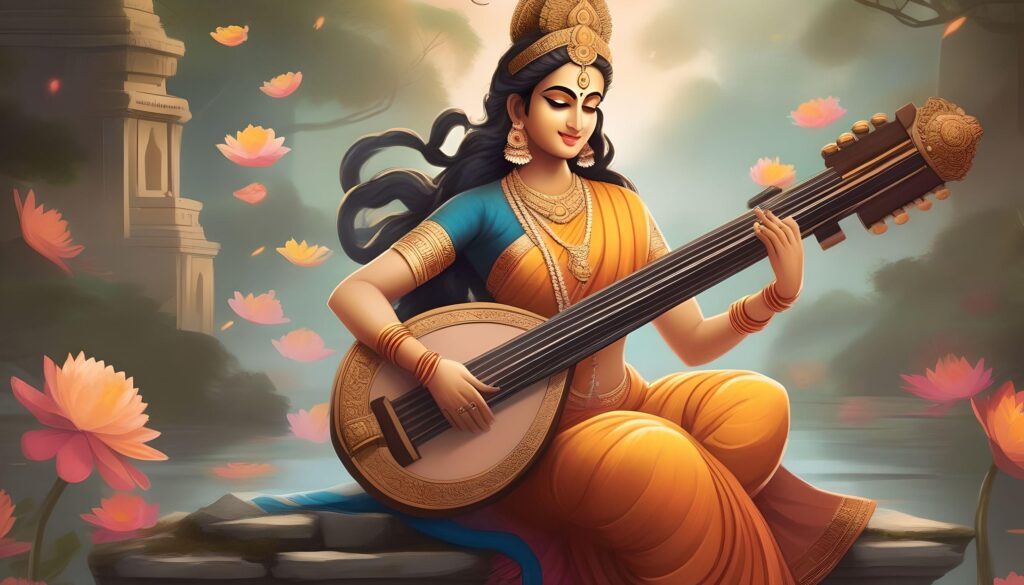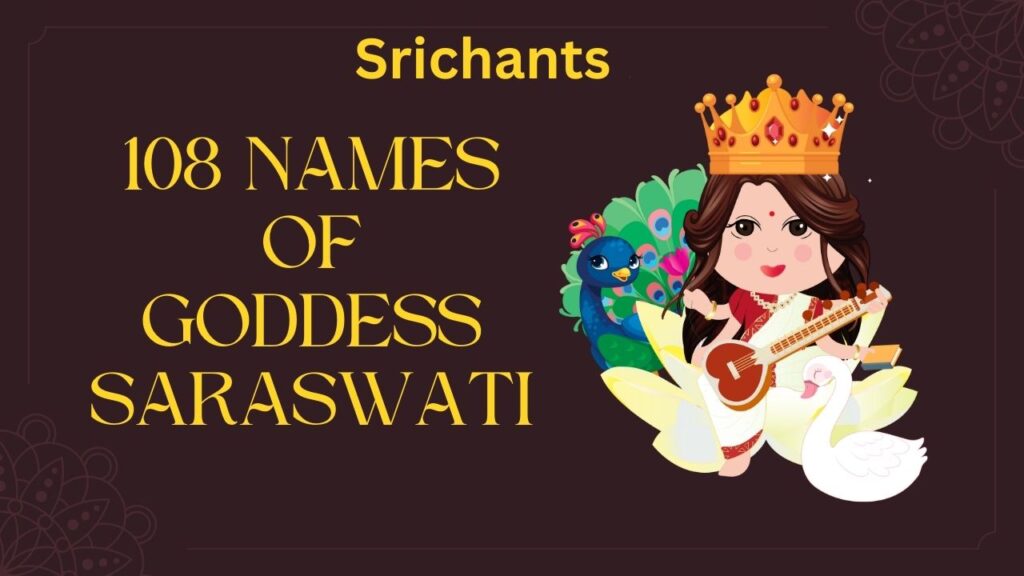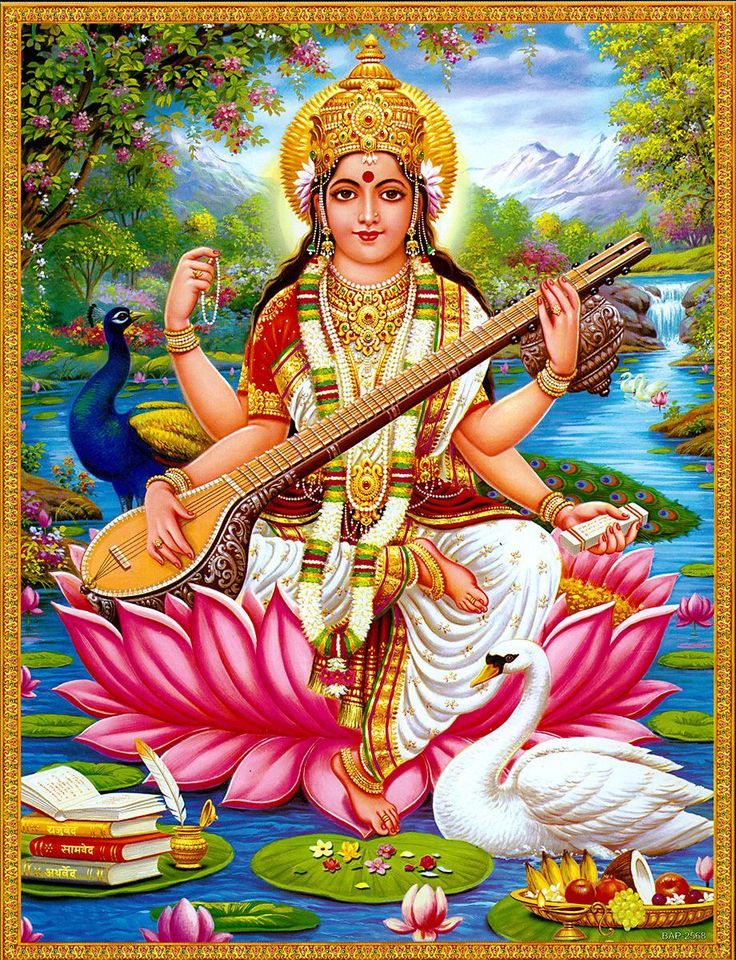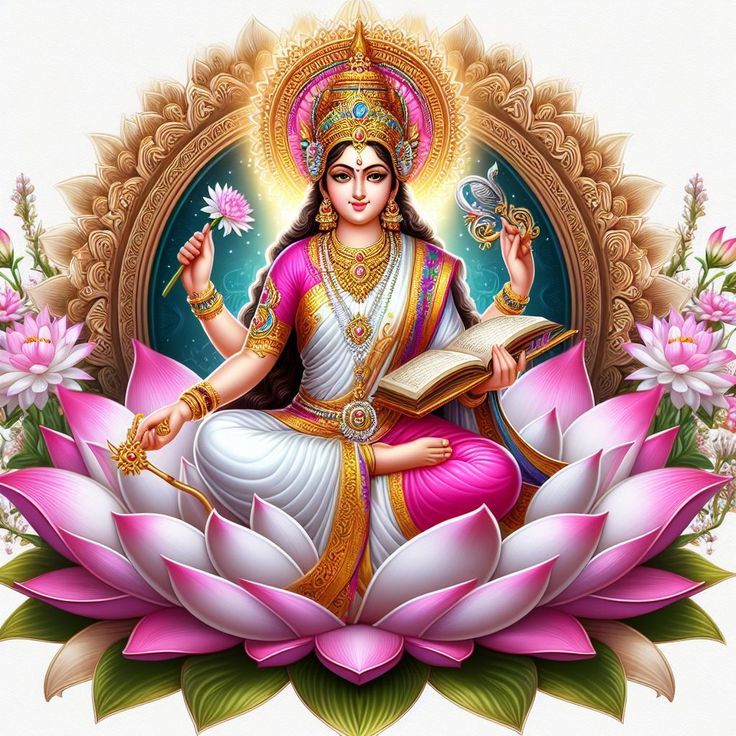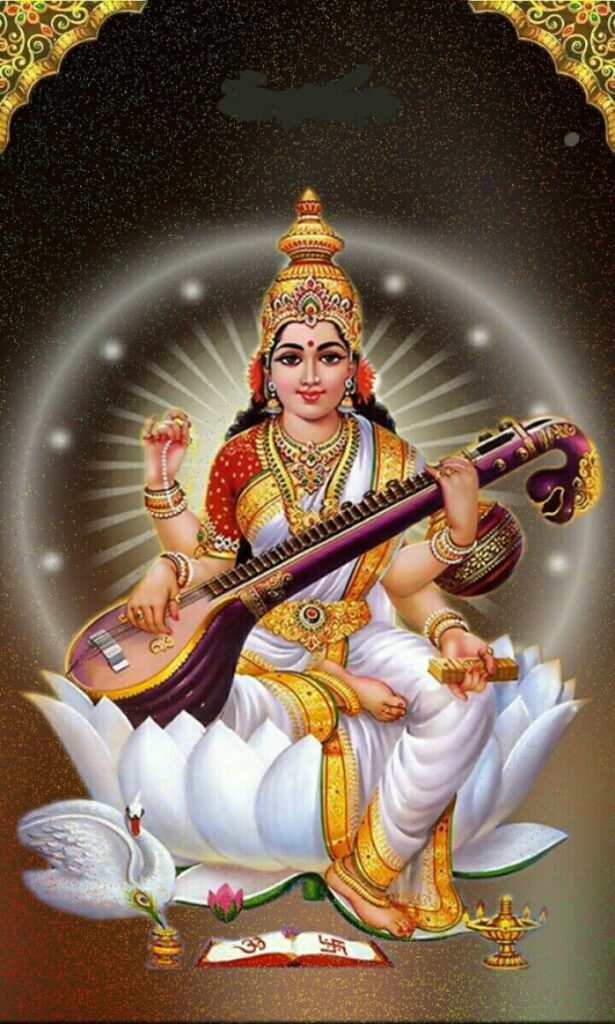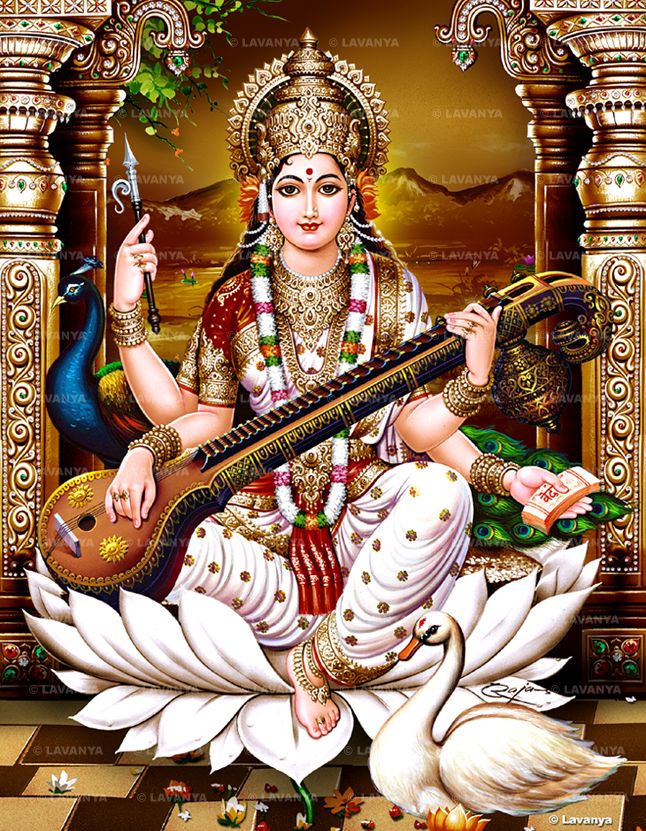Saraswati’s Role in the Creation of the Vedas
Introduction
Among the rich fabric of Hindu mythology, the beloved Goddess Saraswati is a brilliant lighthouse of education, wisdom, and the arts. Her ubiquitous presence in the earliest and most revered books of the faith, the Vedas, is evidence of her great impact on the fundamental bases of Hindu spiritual development. Saraswati is more than just a god; she is the embodiment of enlightenment, the divine source of inspiration that runs across the Vedas’ lines, lighting the road of spiritual insight for searchers over the ages.
The Iconography of Saraswati
Goddess Saraswati’s iconographic portrayal captures her multifarious character by means of a rich tapestry of symbolism. Usually shown as a stunning woman in pure white, Saraswati sits on a white lotus to represent the brightness of knowledge, truth, and purity. Her clothing and accessories, in white tones as well, highlight these traits more especially.
The four facets of the mind and self-awareness—manas (mind), buddhi (intellect), citta (consciousness), and ahamkāra (ego)—are embodied by Saraswati’s four arms. She has the Vedas, a mālā (rosary) for meditation, a water pot signifying cleanliness and prejudice, and a veena, a musical instrument signifying the creative arts and sciences in her hands.
While the peacock, or citromekhala, stands for the transforming power to turn negativity into enlightenment, the goddess’s relationship with the hamsa, or swan, reflects her ability to distinguish good from evil. These rich symbols capture Saraswati’s function as the vehicle for knowledge, imagination, and spiritual sense.

Saraswati’s Several Expressions in Hinduism
Goddess Saraswati is worshiped in several forms and avatars in many Hindu regions and traditions, hence her impact transcends one form. These several representations highlight the complex character of the goddess and her capacity to connect with many spiritual and cultural settings.
Dancing Sarasvati: The Vehicle for Artistic Expression
At Karnataka’s Hoysaleswara temple, Saraswati is portrayed brilliantly in a classical Indian dance form with eight hands. As Saraswati is the patron of knowledge and all kinds of artistic expression, this portrayal depicts her rule over the creative arts since she owns a pen, a palm leaf manuscript, a musical instrument, and implements of major artistic fields.
Mahasaraswati: The Powerful Manifestation
Celebrated in several versions throughout, Mahasaraswati is shown as an eight-armed goddess seated on a white lotus clutching a Veena. Respected for her ability to defeat asuras, or evil powers, she is connected with a strong meditation verse in the Devi Mahatmya, therefore signifying her capability to vanquish ignorance and propel spiritual transformation.

Matrika Avatar: Saraswati the Goddess of Wisdom- Bearing Mother
Saraswati appears in the Shakta tradition as Brahmani, a matrika avatar or mother goddess. In this form she is not only the goddess of knowledge but also the ultimate wisdom and truth. Her Mahavidya form is called Matangi, a clear Tantric rendition of Saraswati.
Vidhya, Gayatri, Savitri: Saraswati’s Many selves
Under many distinct names, Saraswati is worshiped in many areas expressing a particular facet of her divine essence. She is known as Vidhya, the formless notion of knowledge and wisdom; as Gayatri, the personification of the Vedas; and as Savitri, Brahma’s consort and a purity emblem.
Nila Saraswati: The Furious Manifestation
Nila Saraswati is regarded in some religions as a type of Mahavidya Tara. Although the conventional Saraswati is usually shown as peaceful and sympathetic, Nila Saraswati stands for the enraged and destructive expression of the goddess. She is revered in certain parts of India as the potent Goddess Tara reincarnated.

Sharada Avatar in Kashmir: the Goddess of Speech and Learning
Dedicated to the triple embodied form of the goddess Shakti—Sharada (learning), Saraswati (knowledge), and Vagdevi (speaking), the Sharada Peeth in Kashmir One of the Maha Shakti Peethas, this holy site is quite important since it marks the spiritual spot of the dropped right hand of the goddess Sati.
Reflecting her multifarious nature, these several forms and avatars of Goddess Saraswati depict her duties in education, arts, speech, and the more general divine feminine force that penetrates the Hindu spiritual scene.
Saraswati’s presence in the Vedas: The Goddess That Rules Over the Ancient Textues
The oldest and most renowned holy books in Hinduism, the Vedas, firmly establish Goddess Saraswati’s importance in the faith. From the Rigveda, the first of the Vedas, to the later epic and Puranic writing, Saraswati’s presence permeates Hindu spiritual heritage.
From River Goddess to Embodiment of Wisdom, Saraswati in the Rigveda
Originally portrayed as a deified river connected with abundance, power, and the Storm Gods, Saraswati is first found in the most ancient Vedic scripture, the Rigveda. Symbolic of the Waters and the Storm Gods, she creates a triad with the sacrificial goddesses Ila and Bharati. Linked with riches, abundance, health, cleanliness, and healing, Saraswati is among the Apas (water deities).
But Saraswati’s influence goes beyond her first connection with the physical river since, particularly in the fields of poetry and religion, she comes to rule “dhī,” which stands for inspired thought, intuition, and intelligence. From a river goddess, Saraswati’s metamorphosis shows her rising to represent celestial knowledge and wisdom.

Saraswati: the Goddess of Knowledge and Speech in Epic Literature
The major Hindu epics confirm Saraswati’s existence even more. According to the Mahabharata, Saraswati is the goddess of knowledge and speech as well as a revered river for pilgrimages. Her peaceful riverbanks draw sages and priests engaged in asceticism and sacrifices, hence underscoring her function as a spiritual food and illumination source.
As the goddess of wisdom, the Ramayana describes an occasion whereby Saraswati steps in to stop a certain catastrophe by affecting the boon given to a rakshasa, or evil being. This tale emphasizes Saraswati’s virtue and protection as well as her capacity to use her divine wisdom for the benefit of others.
Saraswati in Puranic Writing: The Vedas’ Mother
The Puranic books go on to highlight Saraswati’s importance, characterizing her as produced by Brahma for that aim of creation. Different Puranas show Saraswati’s marriage with Brahma and her function as the mother of the Vedas, depicted by her typical four-armed form clutching a book, mala, veena, and a water pitcher while mounted on a swan.
As shown by the development of faces on Brahma’s sides and back of his head, the Matsya Purana explores the complex relationship between Brahma and Saraswati, stressing Brahma’s great longing for the goddess and the cosmic relevance of their union. Originally one of Vishnu’s wives, Saraswati’s jealousy of Ganga’s looks toward him sets off a sequence of curses that mold the destinies of the three goddesses in the Bhagavata Purana as well.
Saraswati in Shakta Traditions: the Divine Feminine Embodiment
Within the Shakta tradition, Goddess Saraswati takes on an even more central role and is integral in the Devi Mahatmya, a foundational work from the Markandeya Purana. This book discusses the idea of the “triple goddess” (Tridevi), in which Saraswati, together with Mahakali and Mahalakshmi, stands for the saguna (“with form”) emanations of the highest goddess, Mahadevi. Within this framework, Saraswati represents the active, creative principle within this holy triad.
Saraswati appears as Matangi, sometimes called as the “Tantric Saraswati,” in Tantric Shakta traditions. Matangi is also connected with conquering foes, fighting disease, and treating impurity even while keeping qualities of music and learning. Among the eleven Mahavidyas, the strong goddesses in Shakta tradition, she is unique.

Matangi’s importance reaches into the Shri Vidya Shaktism, where she is regarded as Shyamala, a form of Lalita Tripurasundari’s wisdom power. In this setting, Matangi is observed in the Syamala Navaratri and is considered as Lalita’s prime minister, therefore stressing Saraswati’s function as the vehicle of the divine feminine force.
Inspiring Seekers on the Vedic Spiritual Journey: Saraswati’s Legacy
The widespread presence of Goddess Saraswati in the Vedas and her several forms across Hindu traditions help to establish her as a timeless symbol of enlightenment and the divine wellspring of inspiration running across the old writings. Saraswati is still honored whether as the mother of the Vedas in Puranic literature, a cosmic power in Tantric traditions, or a holy river in the Mahabharata, motivating seekers on the spiritual path summed up in the Vedas.
Rich in symbolic meaning, her iconography reflects the core of knowledge, creativity, discrimination, and purity, thereby presenting a great portrait of the goddess in Hindu mythology. Saraswati’s impact goes beyond the confines of one goddess since she embodies the very core of the Vedic teachings, therefore guiding the road of spiritual knowledge for many generations of scholars and followers both.
Conclusion
Celebrated as the “Goddess That Pervades The Vedas,” Goddess Saraswati is evidence of the great impact of the divine feminine on Hindu spiritual life. From the Rigveda to the Puranas and Tantric writings, her multifarious presence highlights the range of her importance. Saraswati’s legacy inspires and guides searchers on the transforming road contained inside the Vedic books, therefore illuminating the road towards enlightenment and the realization of the divine as the embodied knowledge, wisdom, and the arts.
#vedas #veda #Upanishads #sanskrit #goddess

